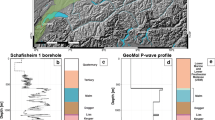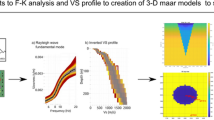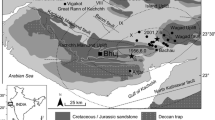Abstract
This study uses the seismic refraction and noise measurements to investigate the velocity structure of the subsurface and emphasize the advantage of ambient vibration over the conventional seismic refraction technique. Field measurements were carried out at nine sites in and around Zagazig city. Shallow seismic refraction data were interpreted using the delay time method to obtain the two-dimension ground model at each site. Ambient vibration arrays are used to infer the one-dimensional compressional and shear wave velocity profiles through two main steps. The first step is to derive the dispersion curve from the recorded signals using the frequency-wavenumber method. The second is to invert the dispersion curve to obtain the site velocity profiles. The results of the compressional wave velocities obtained from seismic refraction technique showed that the subsurface consists of a number of layers ranging from two to four layers and give a good agreement with the results of the seismic wave velocities obtained from the ambient vibration arrays. The ambient vibration arrays gave a deeper depth of penetration than the other method, providing more information on the subsurface structure without any disturbance to the environment. This work provides reliable estimates of the seismic velocity structures of both shallow and deep sedimentary layers within the area of interest.







Similar content being viewed by others
References
Abd El-Gawad AM (1997) Shallow geophysical exploration for defining the water occurrences in the area east of the Nile Delta, Egypt. Ph D Thesis Fac Sci Ain Shams Univ Cairo Egypt 410
Aki K, Richard PG (2002) Quantitative seismology, Second Edition. Univ Sci Books
Asten MW, Henstridge JD (1984) Array estimators and use of microseisms for reconnaissance of sedimentary basins. J Geophys 49:1828–1837
Bayoumy MR (1971) Pedological studies on agricultural expansion areas west of the Suez Canal. M Sc Thesis Fac Agric Cairo Univ Egypt 85
Bonner BP, Schock RN (1981) Seismic wave velocity. In Touloukian YS, Judd WR, Roy RG (Eds) Physical Properties of Rocks and Minerals. McGraw Hill/CINDAS Data Series of Material Properties McGraw-Hill New York, II:2.
Capon J (1969) High-resolution frequency-wavenumber spectrum analysis. Proc IEEE 57:1408–1418
Chouet B, De Luca G, Milana G, Dawso P, Martini M, Scarpa R (1998) Shallow velocity structure of Stromboli Volcano, Italy, derived from small–aperture array measurements of strombolian tremor. Bull Seismol Soc Am 88:653–666
El-Gamili MM, Hassaneen AGh, El-Mahmoudi AE (1990) Geophysical implications in Environmental Geology for Development of the eastern Nile Delta. ARE J Geophys Proc 3rd Sci Gen Meet NRIAG 117–125.
Geological Survey of Egypt (1971) Compiled geological map of Egypt, Cairo, Egypt
GPC and CONOCO (1987) Geological map of Egypt. Scale 1:500.000 Maadi Cairo Egypt.
Hegab O, Bahloul M (1987) The occurrence of peat in the subsurface Holocene sediments of the Nile Delta and its geotechnical implications. Egypt J Geol 31:73–83
Kind F, Fäh D, Giardini D (2005) Array measurements of S-wave velocities from ambient vibrations. J Geophys Int 160:114–126
Köhler A, Ohrnberger M, Scherbaum F, Wathelet M, Cornou C (2007) Assessing the reliability of the modified three–component spatial autocorrelation technique. J Geophys Int 168:779–796
Kohnen H (1974) The temperature dependence of seismic waves in ice. J Glaciology 6(13):144–147
Lacoss RT, Kelly EJ, ToksÖz MN (1969) Estimation of seismic noise structure using arrays. J Geophys 34:21–38
Okada H (2003) The microseismic survey method: Society of Exploration Geophysicists of Japan. Translated by Koya Suto, Geophys. Monograph Series (12) Soc Explor Geophys
Picozzi M, Parolai S, Richwalski SM (2005) Joint inversion of H/V ratios and dispersion curves from seismic noise: estimating the S-wave velocity of bedrock. J Geophys Res Lett 32. doi:10.1029/2005GL022878
Satoh T, Kawase H, Matsushima SI (2001) Estimation of S-wave velocity structures in and around the Sendai Basin, Japan, using array records of microtremors. Bull Seismol Soc Am 91:206–218
Serag El-Din HM (1989) Geological, hydrochemical and hydrological studies on the Nile Delta Quaternary aquifer. Ph D Thesis Fac Sci Mansoura Univ 300
SESAME project (2004) Site effects assessment using ambient excitations: Guidelines for the implementation of the H/V spectral ratio technique on ambient vibrations measurements, processing and interpretation. SESAME European research project
SHAPWASCO (2007) Sharkia portable water and sanitation Co
SHAPWASCO (2008) Sharkia portable water and sanitation Co
Shata AA, Abd El-Salam AA, Hagar AA (1979) Project soil map of Egypt, Soil map of eastern Delta region (El Tumylat-Suez). 4th report Acad Sci Res Tech 20
Tokimatsu K (1997) Geotechnical site characterization using surface waves. In Ishihara (ed) editor Proc 1st Int Conf Earthq Geotech Eng Balkema 3:1333–1368
Wathelet M, Jongmans D, Ohrnberger M (2004) Surface wave inversion using a direct search algorithm and its application to ambient vibration measurements. Near Surface Geophys 2:211–221
Wathelet M, Jongmans D, Ohrnberger M, Bonnefoy-Claudet S (2008) Array performances for ambient vibrations on a shallow structure and consequences over Vs inversion. J Seismol 12:1–19. doi:10.1007/s10950-007-9067-x
Zaghloul ZM, Taha AA, Hegab O, El-Fawal F (1977) The Neogene-quaternary sedimentation basins of the Nile Delta. Egypt J Geol 21(1):1–48
Acknowledgment
The authors are greatly appreciated to the team works from the Seismology Department, National Research Institute of Astronomy and Geophysics (NRIAG), Helwan, Egypt for performing the measurements. Thanks to Dr. Adel El-Shahat Assistant Professor of Geophysics, NRIAG, for his valuable scientific discussions. Also, thanks to Sharkia Portable Water and Sanitation Co. for providing the borehole data.
Author information
Authors and Affiliations
Corresponding author
Rights and permissions
About this article
Cite this article
Mohamed, A.A., El-Eraki, M.A., El-Kenawy, A.A. et al. Evaluating the structural model from ambient vibration recordings and shallow seismic refraction techniques. A case study of Zagazig City, Egypt. Arab J Geosci 9, 617 (2016). https://doi.org/10.1007/s12517-016-2635-z
Received:
Accepted:
Published:
DOI: https://doi.org/10.1007/s12517-016-2635-z




